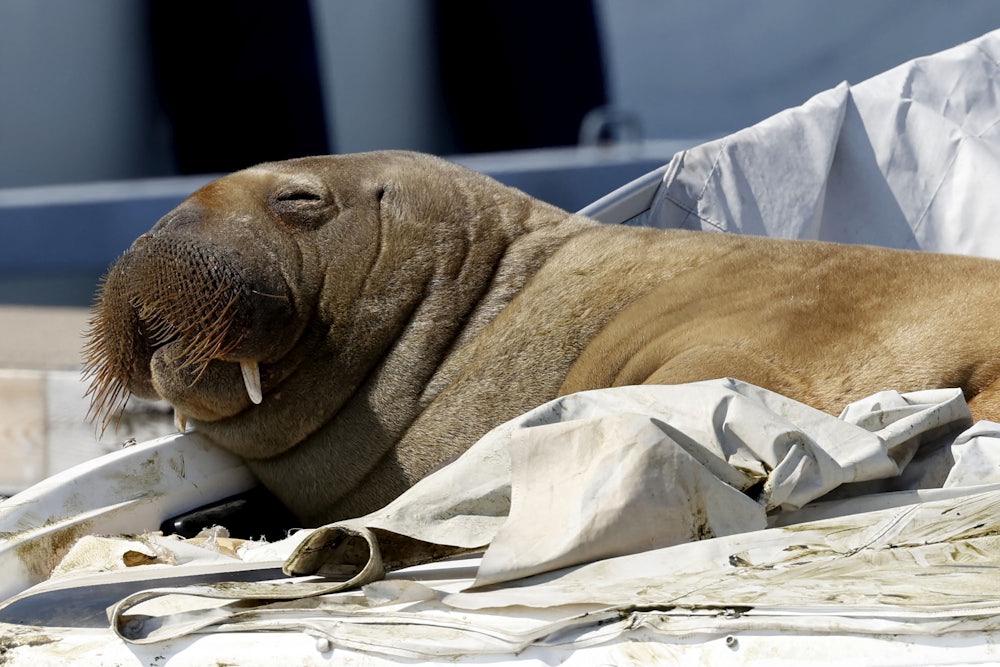Freya was the Norse goddess of love, beauty, and war. That makes her a strange namesake for a 1,300-pound walrus. The tusked sea mammals are known not for their beauty or for their aggressiveness. Freya the walrus, if anything, was better known for climbing aboard yachts in Oslo’s harbor. Until this week, that is. Now she is best known for the local government’s decision to kill her.
The Oslo Directorate of Fisheries announced on Monday that it had euthanized Freya, claiming that she posed a danger to people in the Norwegian capital’s fjord. Oslo’s waters are currently bustling with swimmers, boaters, kayakers, and other recreationalists enjoying the summer heat. “In the end, we couldn’t see any other options,” Olav Lekver, a spokesperson for the directorate, told The New York Times. “She was in an area that wasn’t natural for her.”
What a breathtakingly arrogant statement. Freya was, by all accounts, exactly where she should be: in the waters of a fjord where her species had swam for countless generations. She was not the trespasser. For all our perseverance and adaptations, humans do not naturally live in the waters of Scandinavian fjords. When humans and wildlife meet in places where humans do not belong, it is the humans who should either yield or be held accountable for it. No wild animal should be held to blame for human stupidity.
One purported concern by Oslo officials was that Freya could harm a human being if they strayed too close to her. If such an event had occurred, then that person would have been responsible for what happened, not the animal. A person can be told not to approach wildlife under any circumstances. A person can be urged to not swim with a walrus, or take selfies with a bison, or feed leftovers to bears. A person can also be held accountable when they disregard those warnings. Freya, on the other hand, did not speak Norwegian or know what a “selfie” was or understand why these mostly hairless apes kept swimming up to her.
Humans have the inherent right to defend themselves when they are in danger. So does any other animal. When a person approaches wildlife in a setting where humans do not ordinarily belong, they should not be surprised if an animal attacks them out of self-preservation or territorial defense. I do not want anyone to be injured or killed by a wild animal. At the same time, people should respect and maybe even fear wildlife—and they should fear the natural consequences of getting too close and too comfortable with wild animals.
The world is not so cleanly cut between human spaces and wild spaces, of course. Even in those liminal zones, humans still owe a healthy measure of deference to wildlife. Lake Tahoe, where I grew up, is home to no shortage of large animals. None of them are as dangerous as bears. As a kid, I was taught to only keep food scraps or similar trash in plastic bags inside the house until the morning that a garbage truck came by. People who left their trash in garbage cans on the street the night before would often find them ransacked and clawed apart; bears have even been known to break through garage doors when they pick up a scent.
These encounters have only become more common in recent years. More humans than ever before currently live in Tahoe and the surrounding Sierra Nevada mountains. Climate change has also played a role as animals migrate into unfamiliar territory in search of the means of survival. In the Sierras, persistent droughts and fires have displaced bears from more remote habitats and brought them in closer contact with human communities around and near the lake. Thanks to tourists and new residents who feed bears directly or indirectly through improper garbage disposal, some bears have become more acclimated to human garbage than their normal diets. A bear named Hank the Tank allegedly broke into at least 28 homes in search of meals in recent years, although DNA evidence later proved that three or more bears were responsible. Some media outlets cast the bears as the aggressors in these circumstances, but it can’t be stressed enough that the bears are not truly intruding into human spaces. Humans are consciously and often haphazardly intruding into theirs.
Perhaps the most well-known version of this phenomenon takes place—with sad regularity—in Yellowstone National Park, one of the last great wildernesses of the North American continent. In June, a bison gored a 25-year-old woman from Ohio after she approached the 2,000-pound animal and reportedly came within 10 feet of it. At least three other bison-goring incidents have occurred at Yellowstone so far this year, with the humans bearing a varying degree of responsibility for them. Thankfully, none of their injuries were fatal. But they are a powerful reminder that humans should stay as far away from wildlife as they possibly can—especially when that wildlife weighs as much as some cars.
Some of these encounters have ended in tragedy on the bison’s end. Park rangers at Yellowstone bend over backwards to urge people to not approach any animals for any reason. In one particularly foolish incident in 2016, however, two tourists came across a newborn bison calf, concluded that it “looked cold,” put it in their vehicle, and brought it to park rangers. “Park rangers tried repeatedly to reunite the newborn bison calf with the herd,” Yellowstone officials told reporters at the time. “These efforts failed. The bison calf was later euthanized because it was abandoned and causing a dangerous situation by continually approaching people and cars along the roadway.”
Indeed, in some circumstances, euthanizing wildlife may be necessary if it will otherwise die a slow and painful death, if a specific animal intentionally pursues and kills humans, or if it poses a strong risk of intentionally harming people. Humans also have their own territories that animals should not enter. A person who finds a snake in their garage would be right to safely dispose of it. So would a rancher who protects their herd of cattle from wolves or other large predators. Non-lethal solutions may be preferable in some of these circumstances, but humans, like any other animal, have the right to protect their homes and livelihoods.
It is far from clear whether Freya’s death was even remotely justifiable on those grounds. In other circumstances, wildlife officials have often anesthetized and relocated animals that strayed too far into human environments. Oslo officials disclaimed that option as “too high risk,” without stating for whom the risk would be born. According to the Times, a local researcher who had studied Freya claimed that the walrus would have likely left the Oslo fjord of her own volition at some point, just as she had done in the past.
But Norwegian officials appear undeterred by the backlash. The uproar even prompted Jonas Gahr Støre, the country’s prime minister, to defend their agency’s killing. “I support the decision to euthanize Freya,” he told a Norwegian news outlet. “It was the right decision. I am not surprised that this has led to many international reactions. Sometimes we have to make unpopular decisions.” Nobody begrudges an elected leader who does something unpopular from time to time if they think it is right. In this case, however, killing Freya was not popular because it was not right.










